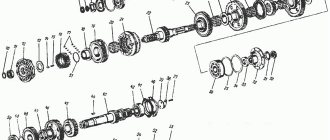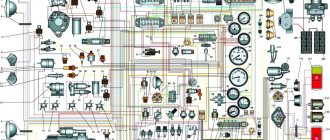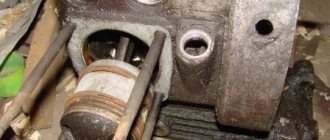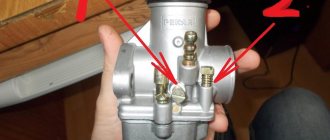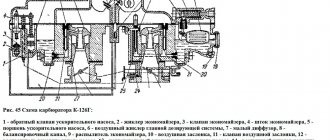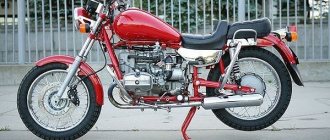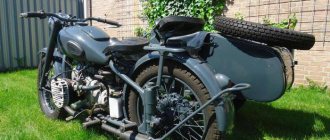Basic information about the transfer case of the Ural 5557 and 4320
The Ural 4230 and 5557 vehicles use a two-stage transfer case equipped with an asymmetrical cylindrical center locking differential with a power drive. The transfer case is mounted on the car frame using four rubber pads. The design of the transfer case of the Ural 5557 and 4320 is absolutely the same as that of the KamAZ 4310.
In the middle of the crankcase the following are located on bearings:
- Intermediate roller with gears of the lowest high gear;
- Rear drive shaft with middle axle. An asymmetrical cylindrical center differential is installed on these rollers;
- Front axle drive shaft;
- The primary roller has high and low gears, and a clutch is installed between them to change gears.
In order to maintain atmospheric pressure in the crankcase cavity, a fitting with a tube is installed on the bearing cover, connecting the crankcase to the atmosphere through a sealing system. The outlet tip of the tube is brought to a level above the maximum fordability to prevent water from being sucked into the crankcase while overcoming water obstacles.
The crankcase is made of cast iron, there is a hatch on top, the crankcase itself is one-piece, closed with a lid with an oil guide tray. Oil is poured into the crankcase through the top hatch with the cover removed or through the hole under the control plug, which is located on the rear wall of the crankcase. The oil is drained through the bottom hole, which is closed with a plug with a magnet. The crankcase is ventilated using a fitting, and its tube is included in the general sealing system of the units.
Transfer case Ural 4320
How does the transfer case Ural 4320 and 5557 function?
In the Ural 4320 and 5557, the torque supplied to the drive wheels can change. That is, the transfer case is considered at the same time an additional gearbox, which increases the number of gears and the limits of change in the gear ratio in the transmission. Thanks to the inclusion of a low gear in the gearbox and transfer case Ural 4320, 5557, it is possible to overcome high resistance to movement and stable movement of the machine at low speed.
The Ural 4320 and 5557 boxes with a rigid connection between the drive rollers of the drive axles have a ratio of torques that are supplied to the main gears of the drive axles, depending on certain parameters of the machine design and driving conditions. With the drive locked and driving straight on roads with good grip but little resistance and differences in wheel radii, certain drive wheels may slip and slide. This leads to faster wear of tires, transmission units and additional loads.
In order to eliminate these undesirable phenomena, a differential drive is used in this part. In this case, the torque is distributed between the drive rollers of the drive axles using a differential, which allows these rollers to rotate at angular speeds different from each other. Thanks to the properties of the installed differential, torque is distributed between the drive axles. That is, thanks to the transfer case differential, costs are reduced while driving on the road. Although the use of a drive differential while driving on slippery roads that have little grip can lead to a decrease or loss of vehicle maneuverability. To increase cross-country ability, vehicles are equipped with a device that blocks the differential.
Common malfunctions of the transfer case Ural 4320, 5557
Ural 4320 and 5557 boxes may have the following problems:
- Difficulty shifting gears of the transfer case differential unit. Most often, this problem occurs when burrs form on the couplings and pliers, the clamps jam, and the sliders bend. To eliminate this problem, it is necessary to clean the tongs and parts of the clamp, as well as put the sliders in order, straightening or replacing them.
- Loud noise. This problem can arise due to damaged gears and displacement of the rollers among the axial directions. In this case, it is necessary to check the adjustment of the bearings in the first and intermediate rollers, and also adjust the oil level.
- Oil leaks through the seals. This problem can occur due to wear of the seals during the formation of cracks. To solve this problem, it is necessary to replace damaged parts and clean the tube, which is responsible for sealing.
- The transmission and differential unit disengage on their own. Most often, this problem occurs due to damage to the switch forks and coupling connections, as well as due to movement of the rollers. To correct this problem, you need to replace worn parts and adjust the roller bearings.
We hope that our article gave you all the answers to your questions and now you have gained basic, basic knowledge on this topic. Good luck on the road and follow the traffic rules!
Design + repair + adjustment of the transfer case of the Ural car
The Ural-4320 and its modifications are equipped with a mechanical two-stage transfer case (Fig. 1) with an asymmetrical center differential.
During the operation of the vehicle, the transfer case is periodically and routinely removed from the vehicle to inspect and adjust the axial play of the primary and intermediate shafts. It is advisable to eliminate any detected faults at the same time.
The design of the transfer case allows the input shaft with gears and the drive shafts of the front and rear axles to be removed from the crankcase without completely disassembling it.
The rear axle drive shaft can be removed as an assembly with the differential. Malfunctions such as lubricant leakage, loosening of the flange nuts on the shafts can be eliminated without removing the transfer case from the vehicle.
Elimination of such malfunctions as arbitrary shutdown of gears (wear of the splines of the gearshift carriage and the input shaft) or differential locking (wear of the splines of the differential lock clutch and the front axle drive shaft), breakdown, improper fit of parts, as well as adjustment work in the scope of maintenance, is carried out on a transfer case removed from the vehicle and partially disassembled.
The need to completely disassemble the transfer case rarely arises and, as a rule, after long-term use of the vehicle.
Lubricant leaks should be detected by inspection and eliminated by tightening plugs, bearing cap bolts or replacing gaskets and seals.
Random gear disengagement and differential locking may be detected when the vehicle is driven with a variable load in difficult road conditions. In this case, the transfer case control levers move arbitrarily:
— gear shift lever towards neutral position;
— the differential lock lever in the direction of disengaging the lock.
With increased wear, scuffing and breakage of transfer case parts, the operating noise changes, and extraneous knocking noises may appear when the vehicle is driven under normal road conditions.
Drivers with operating experience and mechanics usually detect these malfunctions by ear.
Model history and purpose
Production of models of the Ural 4320 line began in November 1977. The release of the series in a noticeably modernized form continues at the present time. The predecessor of the car was the Ural 375D, which debuted back in 1961. With this model, the Ural 4320 was unified in many elements. Initially, the car was equipped with a gasoline unit with high fuel consumption (about 40-48 liters per 100 km), which was considered its main drawback. Diesel versions of the truck (with a KamAZ engine) appeared only in 1978. Moreover, their number in the first years of production was limited. However, the plant gradually switched to the mass installation of Kama diesel engines in the Ural 4320. This was the main difference between the first generation of the model and the Ural 375D.
The basis of the design of the Ural 4320 was a supporting frame, providing high strength. Single-ply tires, all-wheel drive and short overhangs ensured good cross-country ability of the vehicle.
In 1986, the truck was updated. At the same time, the appearance of the model has been preserved almost unchanged. The motor range has not undergone any significant changes. The main unit remained the KamAZ-740 engine. It was used until 1993. However, after a fire at the manufacturing plant, supplies of the power plant ceased. Instead, the Ural 4320 began to be equipped with engines from the Yaroslavl Motor Plant (YaMZ-238 and YaMZ-236). Initially, modifications with the YaMZ-238 were distinguished by a long engine compartment; versions with the YaMZ-236 retained the same shape. However, since the mid-2000s, all variations of the Ural 4320 have received an extended engine compartment.
In the mid-1990s, the truck underwent a restyling. The car began to be equipped with a wide bumper with headlights, and plastic plugs were installed on the wings in the previous place where the headlights were attached. For the needs of the Ministry of Defense, cars with a narrow bumper were still produced. In 1996, production of a lightweight version of the Ural 43206 with two axles began.
The next update occurred in 2009. The car has noticeably changed, receiving a modernized cabin with a fiberglass tail at the front. The shapes of the Ural 4320 have become more streamlined. The classic radiator grille with vertical lines on some versions was replaced by a grille with horizontal lines. On some modifications, they began to install the Iveco “P” cabover type from the UralAZ-IVECO joint venture. It was distinguished by an original rounded integral hood. The previous units were replaced with modern diesel engines YaMZ-536 and YaMZ-6565, which comply with the Euro-4 standard.
In 2014, the Ural 4320 series was transformed into the Ural-M series, maintaining most of the characteristics. In the fall of 2015, another modernization took place. Its result was the appearance of the Ural Next series, which was distinguished by a modern GAZelle Next-type cab with a new plastic tail of the engine compartment and improved components.
Specifications
Engine
The latest versions of the Ural 4320 are equipped with several variants of V-shaped diesel engines produced by the Yaroslavl Motor Plant. The most widely used models are:
- YaM3-236NE2 : displacement – 11.15 l, rated power – 230 hp, maximum torque – 882 Nm, number of cylinders – 6;
- YaM3-236BE : working volume – 11.15 l, rated power – 250 hp, maximum torque – 1078 Nm; number of cylinders – 6;
- YaM3-238 : displacement – 14.86 l, rated power – 240 hp, maximum torque – 882 Nm; number of cylinders – 8;
These units were liquid cooled. The power supply system is a mechanical in-line injection pump.
The YaMZ-7601 unit (rated power – 300 hp) is installed upon request.
Transmission
The wheel formula is 6x6. 4320 has high cross-country ability, which can be achieved using single-pitch wheels with automated adjustment of air filling of the chambers on all wheels. The suspension installed in front is dependent and rests on semi-elliptical springs with double-acting shock absorbers. There are also dependent ones at the rear and they are located on springs with reaction rods. The Ural-4320 has all axles (there are only 3) driven. The wheels that are in front and which are also controlled by the steering wheel have CV joints. The YaMZ-182 clutch has a friction drive, where the pneumatic amplifier is located, and has one disk with a diaphragm pull-type spring.
With a 2-speed manual transfer case, front-wheel drive is always on. The manual transmission of the Yaroslavl Motor Plant contains 5 gears with a locked center differential, and is perfectly synchronized. So, it allows you to get 10 gears for forward movement and a couple of speeds for reverse. The transfer case contains a center locking differential, which distributes torque between the drive front axle and a pair of drive axles at the rear in a ratio of 1 to 2.
These gearboxes are controlled mechanically. Cardan transmission – 4 cardan shafts. The main gear of the drive axles is double, containing a pair of bevel gears and a pair of cylindrical gears. The robust bumper at the front and rear has been fitted with strong towing devices in the form of hooks and a tow bar on the frame, enhancing the truck's technical capabilities.
Brake system
It includes two systems: a 2-circuit working vehicle and a spare single-circuit vehicle. In addition, there is an auxiliary function of brakes with pneumatic drive from the exhaust system. The braking system is mechanical and has a brake drum on the transfer case. The parking brake design is of a drum type, installed on the output shaft of the transfer case.
Scheme
Gearbox diagram
Electrical diagram
Diagram of hydropneumatic clutch drive
Brake system diagram
Dismantling the transfer case
It is more convenient to remove the transfer case if the car is installed on an inspection ditch in a room equipped with a lifting device.
To dismantle the transfer case from Ural-4320, -4420 and -44202 vehicles, lower the folding bracket of the spare wheel holder and remove the wheel.
Remove the driveshaft of the middle axle drive, disconnect the flanges of the driveshafts of the intermediate, front axle drive and front winch drive from the flanges of the transfer case and the additional power collection box.
Disconnect the wires from the speedometer sensor.
Undo the cotter pins and remove the pins, disconnect the rear ends of the control rods for the transfer box, auxiliary power take-off box and parking brake.
Unscrew the sealing tube from fitting 11. Move the disconnected ends of the cardan shafts and control rods of the transfer case, additional power take-off and parking brake to the side and secure them to the vehicle frame.
Fasten the load-lifting device to the bracket on cover 4 of the top hatch of the transfer case and lightly tighten the slings of the lifting device.
Undo the cotter pins and unscrew the nuts of the studs securing the transfer case to the brackets, remove the cushions and washers, carefully lower the box onto the trolley and remove it from under the car frame.
Device
The basis of the car is a load-bearing riveted frame made of high-strength steel and characterized by increased rigidity. The design provides short rear and front overhangs, thereby increasing cross-country ability. The platform for transporting people and cargo is made of metal. It has lift-up side seats and an opening tailgate. The body assumes the possibility of installing an awning, arches and mounting sides on both sides. Some modifications received a wooden platform. The sides of the Ural 4320 are lattice or solid. The design provides for a front location of the unit. To access the engine, the hood opens upward. On the sides there are wide, flat fenders that protect the cabin from foreign objects and dirt while driving.
The truck has a 6 by 6 wheel arrangement. The model is equipped with single wheels with automatic adjustment of the air filling of the chambers on 3 drive axles. Recommended tires: 14.00-20 OI-25.
Operating principle and troubleshooting of the Ural gearbox
The Ural gearbox is a device in the vehicle system that is responsible for transmitting power.
How does the checkpoint work?
The KPP-141 device, installed on some Ural models, includes the following elements:
- Coupling mechanism. It helps temporarily separate the engine and transmission. This allows you to change gears without reducing the speed of the power unit.
- Driven gears and shafts. The drive, intermediate and secondary shafts are installed here.
- Synchronizer. It ensures silent operation of the mechanism and equalization of gear speeds.
The gears rotate freely when the neutral mode is engaged, at which time all clutches and synchronizers are in the open position.
When the driver begins to squeeze the clutch mechanism and shifts the handle to some other gear, a special fork device begins to move the clutch into the engagement position with the corresponding pair at the end of the gear.
The gear mechanism is rigidly fixed to the shaft and stops spinning on it. The clutch in this position facilitates the transmission of rotational motion and traction force.
While the vehicle is moving, the gearbox is activated by the gear shift knob. It moves sliders equipped with forks, which begin to move the synchronizers at the required speed. A color diagram of gear shifting is in the Ural user manual.
Gear ratios of the Ural box:
- first stage - 5.26;
- second stage - 2.90;
- third stage - 1.52;
- fourth stage - 1.00;
- fifth stage - 0.664;
- reverse gear - 5.48.
Malfunctions and repairs
Basic malfunctions and repairs of the box:
- Extraneous noise in the mechanism. In this case, it is recommended to conduct an external inspection of the system and replace damaged and worn parts.
- The shafts move along the axis. It is necessary to replace the parts that secure the bearing, or replace failed bearings.
- Unstable operation of the gearbox. This problem may be due to wear on the reverse spline shaft bushings. Damaged mechanisms should be replaced.
- The clutch does not engage fully. In this case, it is recommended to conduct an external inspection of the coupling mechanism for damage and defects, check the level of lubricating fluid in the system and replace damaged elements.
- The fork rods are difficult to move. This malfunction can be caused by damage to the locking pins and synchronizers. It is necessary to replace the mechanisms with new ones.
- If the gearbox switches off spontaneously, it is necessary to adjust the gap between the valves, replace worn synchronizer rings, install new springs, and tighten fasteners.
- If the switching is unclear, you need to remove the cover of the locking device and inspect the main components for wear, replace the clutch and gears.
Modifications of Ural 4320:
- Ural 4320 – chassis with a basic metal cabin with a load capacity of 7000-9000 kg;
- Ural 4320-19 – long-wheelbase chassis with a lifting capacity of 12,000 kg;
- Ural 43203 – chassis with reinforced front suspension;
- Ural 43204 – chassis with increased load capacity;
- Ural 44202 – truck tractor;
- Ural 43206 - chassis with a 4 by 4 wheel arrangement.
For cars, the Ural 4320 remains the base model. This truck is highly practical and designed specifically for the needs of the army. Its main area of application is the armed forces. However, the machine is also used in the public utilities, forestry, construction, mining and commercial sectors. Here it is in demand as an all-terrain vehicle used for transporting people and equipment.
Stages of adjusting the transfer case differential lock clutch
- The position of the clutch should be checked and, if necessary, adjusted.
- To adjust the position of the clutch, it is worth locking the differential by turning the rod.
- When checking the position of the coupling, you should install the rod, fixing it in the forward position by the flange, turning the shaft related to the front axle drive.
- The correct position of the coupling is when it touches the splined end. If this is not the case, you should move it forward while rotating the rod clockwise.
- To adjust the position of the seventh clutch, it is worth adjusting the selection of the thickness of the gaskets. The coupling is secured normally when the difference between the splines on both sides of the carriage is no more than one millimeter.
The history of the appearance of the Ural-4320 car
Ural-4320 trucks began to be mass-produced in 1977. The main difference between the new truck and the Ural-375D was the presence of a powerful diesel engine, the fuel consumption of which was significantly less than that of the gasoline modification. The military and business executives liked the new model so much that by 1986 the plant had produced more than a million Ural-4320 chassis, on which various bodies were installed.
The first models, which were produced before 1993, were equipped with KAMAZ diesel engines, but after the fire in 1993, the Kama plant stopped supplying its engines to other manufacturers. We had to switch to diesel engines from the Yaroslavl Motor Plant. Since it was not immediately possible to reach an agreement with the Yaroslavl plant on the supply of engines, in 1993 and 1994 he was forced to return to the production of cars with the ZIL-375 gasoline engine. According to its design, it was the same Ural-375D only with a cabin from the Ural-4320.
When it was possible to agree on the supply of Yaroslavl diesel engines, two types of engines were installed on all Ural-4320 chassis:
- YaMZ-238;
- YaMZ-236.
All trucks with YaMZ-236 engines remained externally unchanged, and modifications with YaMZ-238 received a new cabin with an increased size of the engine compartment. In addition to the size of the hood, these modifications can be quickly distinguished by their appearance, since for trucks with YaMZ-236 the air filter simply did not fit under the hood and had to be placed on the right wing. Starting from the mid-2000s, all Ural-4320 chassis received the same cabs with an extended engine compartment.
In 2014, the entire family of trucks on the Ural-4320 chassis was modernized into the Ural-M series. At the same time, the new modification retained the cabin of the 4320 model. In 2015, the entire Ural-M series was modernized by installing the new generation “NEXT” cabin. The truck began to look more modern, although it lost its charm and brutality. Despite this, the Ural-4320 cabin will continue to be installed on the Ural-M chassis, which will be produced for export.
Use in combat conditions
Ural-4320 trucks gained experience in participating in real military conflicts in the very first years after the start of mass production. During the fighting in Afghanistan, these vehicles were actively used in military transport, and sometimes they were equipped with improvised local reservation systems.
In addition, in Afghanistan and in a number of subsequent local conflicts, anti-aircraft machine guns, light guns and portable missile systems were mounted in the back of Ural-4320 trucks. As the successor to the family of vehicles, the Ural-375 served as a new chassis for the famous BM-21 Grad multiple launch rocket systems (MLRS).
At the same time, modernized MLRS and their new generations began to be placed on the basis of the Ural-4320 vehicle. At the same time, the vehicle acted as a means of delivering weapons and loading these and other, more powerful missile systems, including the Tor anti-aircraft missile system, which is still in service with the Russian army.
In general, in the Armed Forces of the USSR and Russia, the Ural-4320 truck actually led the generation of army SUVs, becoming the base vehicle. On its basis, various specialized vans (command and headquarters, radio engineering and others), field repair shops, airfield special equipment, refueling, evacuation and engineering vehicles were equipped.
Exterior and interior of Ural-4320
The basic modification of the Ural-4320 vehicle is a classic flatbed truck with a metal body. The car is equipped with removable arches, an awning and benches in the body. Onboard Ural-4320 has the following characteristics:
- The gross vehicle weight is 8,265 kg;
- The vehicle can carry cargo weighing up to 6,855 kg;
- The weight of the towed trailer can reach 11,500 kg;
- The Ural cabin is designed for three seats;
- The driver's seat is adjustable.
There are modifications equipped with an additional bed.
The process of adjusting the transfer case drive, its control
To adjust the gearbox control drive, it is worth changing the length of the rods five and six forks. It is correct if the rod is in the middle position and corresponds to the neutral position of the clutch, while the location of the second lever should correspond to the middle of the slot in the floor in the cabin. If the top gear is turned off and the differential is unlocked, lever one and lever two (Fig. 1) should be in the same plane. After making adjustments, you should check how easily the gears shift, tighten the pins and tighten the fork locknuts.
Rice. 1 Control of the transfer case of the Ural vehicle
1-differential lock lever; 2-gear shift lever; 3-pressure spring; 4-roller levers; 5.6-thrust; 7.8-leashes; 9-bracket; 10-rod gear shift fork; 11-adjusting gaskets; 12-rod differential lock fork transfer case; I-differential unlocked; II-differential locked; A - forward position of the lever (high gear engaged); B - middle position of the lever (neutral); C-rear position of the lever (low gear engaged)
Source
Line of Ural-4320 engines
Over the entire period of production, many engines of varying power were installed in the Urals, not counting the gasoline ZIL-375:
- KAMAZ-740.10 with a working volume of 10.85 liters. This engine developed power up to 230 hp, and was installed on the truck until 1993. After the terrible fire at the KAMAZ plant, engines were no longer supplied to third-party manufacturers;
- YaMZ-226 is the weakest engine in the line. Its power was 180 hp;
- YaMZ-236NE2 is a four-stroke diesel engine with turbocharging. Its volume was 11.15 liters and its power was 230 hp;
- YaMZ-238M2 with a power of 240 hp;
- YaMZ-236BE2 is the most powerful serial engine installed on the Ural-4320 base chassis. Develops 250 hp.
In addition to these engines, the YaMZ-7601 diesel engine, which has a power of 300 hp, can be installed on the truck upon request.
The Kamaz engine, which was installed in the Urals from 1977 to 1993, was well studied and refined. Having smaller dimensions and weight than the YaMZ-238 engine, it provided the vehicle with high thrust at low speeds. A pre-heater, a high-pressure fuel pump and powerful batteries ensured easy starting of the engine even in winter.
The YaMZ-238 engine has a specific electric torch device for trouble-free engine starting in winter. Those drivers who have a Ural-4320 with this engine need to know one nuance - before turning off the ignition, the driver must let the engine idle for about two minutes.
The technical characteristics of Ural-4320 diesel engines fully comply with Euro-3 parameters. Fuel consumption on a good road near the Urals is about 30-35 liters. If it is a road train, then the consumption increases by 5 liters. If you have to move in off-road conditions, then fuel consumption can increase to 50-60 liters per hundred km. At the same time, the power reserve is 600-1000 km, since the fuel tanks hold 300 liters of diesel fuel. The upgraded Ural-4320 brakes work perfectly in conjunction with all installed motors.
The body of the base model Ural-4320 is made of metal, but wooden bodies are also available. Military flatbed trucks, designed to transport personnel, are capable of transporting about 30 soldiers. The number of seats in the body depends on the modification.
The maximum weight that the Ural-4320 can carry is 10,000 kg. At the same time, you shouldn’t expect a truck to be able to drive off-road with such a weight. The truck's engine is located very high from the ground, thanks to which the vehicle is able to overcome deep fords. Wide front fenders, by which you can immediately distinguish the Ural-4320 from the ZIL-131, prevent dirt from getting into the driver's cabin.
User manual
Regulatory documentation relating to the operation, maintenance (MOT) and repair of Ural 4320 model trucks notes the versatility of this vehicle (transporting people, cargo and towing trailers), as well as its ability to operate on all types of roads in any terrain. The range of ambient temperatures for which the vehicles were designed was quite wide and ranged from plus 50 to minus 50 degrees Celsius.
In addition, the operational requirements reflected the very high reliability parameters of the Miass truck. If the initial maintenance for a new car usually required 1000 km of run or 50 engine hours, then subsequent maintenance was carried out after 4 thousand km or 125 hours of engine operation, and a more in-depth one - at four times higher rates. Moreover, most maintenance items boiled down to tightening nuts, cleaning, etc. operations.
Modifications of Ural-4320
Since 1977, the Ural Automobile Plant has produced many modifications of its popular heavy truck. The design of each of them was somewhat different; only the powerful Ural 4320 axles remained unchanged. Here is a list of the main modifications of the Ural car:
- Ural-4320-01 was released in 1986. This model differed from the basic version in a new, improved cabin (although it was almost invisible from the outside), a new gearbox and an improved cargo platform. This modification was also equipped with a KAMAZ engine;
- Ural-4320-10 is the first modification to receive an engine from YaMZ. It was a six-cylinder YaMZ-236, developing 180 hp. The vehicle was intended to transport people and cargo in off-road conditions. There was a winch that helped when the car got stuck in the mud. True, it was very difficult to pull out the heavy Urals. It often happened that the trees to which the winch was attached were simply uprooted;
- Ural-4320-31 is another one of the first models with a YaMZ engine. This time it is an eight-cylinder diesel engine developing 240 hp. In addition, its settings were very different from the YaMZ-236;
- Ural-4320-30 received an increased wheelbase and load capacity. This model was supposed to be operated in the most severe conditions;
- In 2002, the Ural-4320-41 modification appeared. It was equipped with a YaMZ-236NE2 diesel engine, which met Euro-2 standards. Option 4320-40 featured an extended wheelbase;
- Ural-4320-44, created in 2009, received a new cabin. Model 4320-45 had an extended body;
- The most powerful vehicle in the line was the Ural-4320-48, which received a YaMZ-7601 engine developing 300 hp.
All of the above modifications were produced in various versions, ranging from on-board vehicles and dump trucks, to special equipment for the military and public utilities.
The latest modifications of the Ural-4320 were made taking into account the convenience of the driver. They received new, more comfortable cabins. A stylish tail made of plastic and hoods made of the same material appeared. The new Urals resemble classic American heavy-duty trucks, although the plastic parts are not at all intended for harsh operating conditions.
Ural-4320 became a worthy successor to the gasoline Ural-375D. The creators managed to reduce fuel consumption by 30-40 percent. Today, the Ural continues to attract admiring glances from drivers. A huge heavy vehicle is capable of carrying a heavy load to places where even well-trained SUVs get stuck.
Troubleshooting, as well as regulation of transfer case, drive Ural-4320, 5557
switching the gear of the transfer case differential unit is difficult. Basically, a similar problem is encountered when burrs form on the couplings and tongs, jamming of the clamps is observed, and the sliders bend. To eliminate the malfunction, you should clean the tongs, parts of the clamp and put the sliders in order by straightening them or replacing them.
The differential block and transmission turn off without permission. Basically, such problems arise due to damage to the connections of the couplings and switch forks, and this may also be due to the fact that the shafts have moved. To cope with the problem that has arisen, it is necessary to change parts that have worn out, and it is also worth adjusting the shaft bearings.
oil flows through the oil seals. This problem arises due to wear of the oil seals and cracks in them. To solve this problem, it is worth replacing the damaged parts and blowing (cleaning) the tube responsible for sealing.
